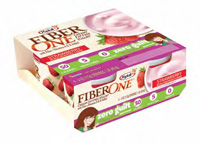Health & Wellness Trends
ADVERTORIAL
While the recession has taken a bite out of some better-for-you foods, the overall functional foods category remains healthy. Sales of functional foods in the United States range from $20–$30 billion and comprise about 5% of the overall U.S. food market, according to an August 2009 report from PricewaterhouseCoopers (PWC) on “Leveraging Growth in the Emerging Functional Foods Industry.” Estimates of annual growth of functional foods range from about 8–20%—well above of overall industry average of 1–4%.
 The United States is the largest market in the world for functional foods, representing 35–50% of global sales, says the PWC report. Asia-Pacific is the second largest market.
The United States is the largest market in the world for functional foods, representing 35–50% of global sales, says the PWC report. Asia-Pacific is the second largest market.
Together, the U.S. and Asia-Pacific account for about three-quarters of the functional foods market.
Beverages and dairy products are the two largest categories of functional foods—constituting about 60% of the functional foods market, according to PWC. Functional beverages (e.g., energy drinks and isotonics) are expected to grow 8.5% annually from 2007 to 2013, accounting for 56% of the global market with sales of nearly $33 billion. Dairy is driven largely by innovations in yogurt. In the past five years, yogurt sales in the U.S. grew about 32% to $4.1 billion. In 2000, about 17% of Americans were eating yogurt on a regular basis. In just 10 years, that number has grown to about 28%.
By functional benefit, energy ranks at the top with 29% of the market of products that boast a health-related claim, reports PWC. Additional leading claims include heart health, bone health, and gut/digestive health. Other functional claims include weight management, mental acuity, and infant/child development. Products that deliver a tangible benefit, like an energy boost, will probably be more successful in the marketplace than products that do not provide “instant gratification”.
Consumer Awareness
Nearly 90% of Americans agree that certain foods have benefits that go beyond basic nutrition, and may reduce the risk of disease or other health concerns—a significant increase from just two years ago, according to a 2009 International Food Information Council (IFIC) Functional Foods/Foods for Health Consumer Trending Survey.
The top functional foods named by consumers in the IFIC survey are: 1) fruits and vegetables; 2) fish, fish oil, seafood; 3) dairy (including milk and yogurt); 4) meat and poultry; and 5) herbs/spices.
In addition, consumers are increasingly associating these foods and their components with specific health benefits such as calcium and vitamin D for bone health, whole grains for reduced risk of heart disease, antioxidants for protection against free radical damage, probiotics for digestive and immune health, and omega-3 fatty acids for cognitive development, especially in children.
While consumers say they want to eat foods for these benefits, the IFIC data suggest they are struggling to follow through and incorporate them into their diet. About 51% of consumers view their diet as somewhat healthful, 21% report that their diet is neither healthful nor unhealthful, 19% say their diet is not very healthful, and 3% perceive their diet as not at all healthful. Only 6% of Americans view their diet as extremely healthful.
Nearly two-thirds (64%) of the IFIC survey respondents have made a change to improve the healthfulness of their diet in the past six months. The major drivers to improve their diet include overall well-being (64%), physical health (61%), lose weight (61%), because of a specific health condition (30%), and maintain my weight (17%).
To lose or maintain their weight, consumers are utilizing a combination of several strategies, according to IFIC. Seventy-one percent of consumers are changing the amount of food I eat, 65% say they are changing the types of foods and/or food components I eat, 62% report they are engaging in physical activity, 44% are changing how often I eat, 19% are counting calories, 19% are consuming diet foods and beverages that contain low-calorie/artificial sweeteners, and 9% are following a specific weight loss/diet program.
